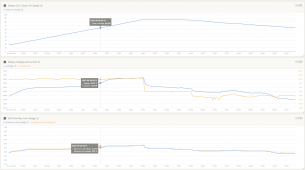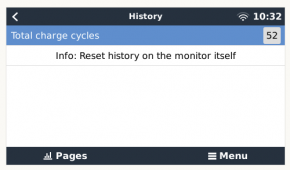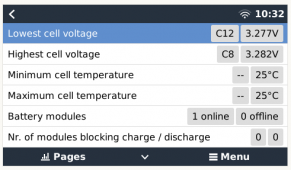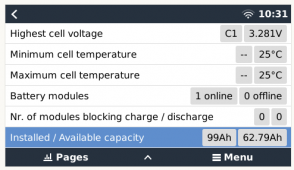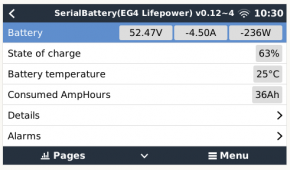You are using an out of date browser. It may not display this or other websites correctly.
You should upgrade or use an alternative browser.
You should upgrade or use an alternative browser.
Victron with eg4 batteries 48v
- Thread starter ohsolar
- Start date
Samsonite801
Solar Wizard
- Joined
- Oct 15, 2020
- Messages
- 2,994
Hi
Does the victron multiplus work with eg4 5k batteries? Any issues?
Victron looks a lot more expensive than eg4 inverters but the software looks awesome
Victron software does work awesome.
But my bigger question might be, can the Victron ecosystem CAN bus comms protocol achieve successful connection/communication with EG4 or EG4 LL battery packs?
If not, I suppose one could just use a BMV or SmartShunt to read SoC too at least...
Lilikoi_Heavy_Industries
Solar Enthusiast
- Joined
- May 9, 2022
- Messages
- 243
I use multiplus II 48/3000 with 2x EG4 lifepower4 48V 100AH batteries. Communications doesn't work, but everything works fine otherwise. I'm very happy with them so far.Hi
Does the victron multiplus work with eg4 5k batteries? Any issues?
Victron looks a lot more expensive than eg4 inverters but the software looks awesome
They released a new battery in the last few days, not the base model, but a V2 of the more expensive one, and are claiming it has victron comms now I believe.
Lilikoi_Heavy_Industries
Solar Enthusiast
- Joined
- May 9, 2022
- Messages
- 243
If you have existing battery packs, so far, the VenusOS dbus-serialbattery driver doesn't support them yet, or it didn't last time I tried a couple months ago.Victron software does work awesome.
But my bigger question might be, can the Victron ecosystem CAN bus comms protocol achieve successful connection/communication with EG4 or EG4 LL battery packs?
If not, I suppose one could just use a BMV or SmartShunt to read SoC too at least...
I did find some go code on github that was able to pull some data off the packs so I have some hope that we'll get this battery hacked into the Victron drivers.
Here is the current status of adding support for the existing lifepower4 into this driver that can be added to a victron cerbogx (or rpi):
Add EG4 Lifepower driver by dchiquito · Pull Request #212 · Louisvdw/dbus-serialbattery
Fixes #137 Marking as draft pending more complete testing. I've tested this locally on my laptop with a EG4-LiFePower4 | 24V 200AH, but not on an actual Venus OS installation or any other EG4 batt...
Samsonite801
Solar Wizard
- Joined
- Oct 15, 2020
- Messages
- 2,994
They released a new battery in the last few days, not the base model, but a V2 of the more expensive one, and are claiming it has victron comms now I believe.
You might be referring to the newer EG4 LL (Long-Life) release? I have a friend who says he's an affiliate rep for selling Signature Solar, and he said the new LL packs have better comms compatibilities with common brand inverters than the standard ones.
Perhaps it's a v2 variant of the LL (the LL being the more expensive one you refer to)...
Last edited:
David Collins
New Member
- Joined
- Sep 15, 2022
- Messages
- 21
Do you know if this new version will actually communicate data to the Victron controller in a way that affects its direct performance, or is it just a BMS program that adjusts presets in the BMS to affect how the battery responds to different controllers?You might be referring to the newer EG4 LL (Long-Life) release? I have a friend who says he's an affiliate rep for selling Signature Solar, and he said the new LL packs have better comms compatibilities with common brand inverters than the standard ones.
Perhaps it's a v2 variant of the LL (the LL being the more expensive one you refer to)...
Lilikoi_Heavy_Industries
Solar Enthusiast
- Joined
- May 9, 2022
- Messages
- 243
No. You can buy one of the new batteries as a master battery.
Looks like the SW will be ported to the older models. Did I read that right?
That new V2 master battery can then talk to your previous model batteries and become a gateway enabling the other batteries to feed data to the inverter through the V2 battery--I think it's normal design for one master battery to report all of the battery packs' status to the inverter already.
In order for your V1 batteries to communicate to the V2 batteries to make this work it sounds like they're planning to release a firmware update for V1, from the video contents "stay tuned".
Last edited:
Samsonite801
Solar Wizard
- Joined
- Oct 15, 2020
- Messages
- 2,994
Do you know if this new version will actually communicate data to the Victron controller in a way that affects its direct performance, or is it just a BMS program that adjusts presets in the BMS to affect how the battery responds to different controllers?
I don't know, I was just over talking with the guy here who says he's an affiliate seller, but I didn't think to ask him any questions about Victron integration. He may not even know and have to defer to his contacts. I'll check with him in the next couple days when I see him again, see if he has any idea.
I wonder if they have a new manual release which would cover the new model (with v2 FW), will have to check on it. Or maybe the Release Notes...
Last edited:
FYI, I emailed signature solar about this today regarding if the new LL V2 can act as a master to the "normal" EG4 Lifepower4's and here is the response:
sad that I didn't realize this until I got my shipment. looks like I'll have to go another route...anyone need batteries?
Unfortunately we are unable to support that as of yet. The batteries have different brands of BMS and can not communicate with one another. This is something we are working on finding a solution for, but at the moment we do not have the ability to do so.
sad that I didn't realize this until I got my shipment. looks like I'll have to go another route...anyone need batteries?
Lilikoi_Heavy_Industries
Solar Enthusiast
- Joined
- May 9, 2022
- Messages
- 243
There is some news in this area.FYI, I emailed signature solar about this today regarding if the new LL V2 can act as a master to the "normal" EG4 Lifepower4's and here is the response:
sad that I didn't realize this until I got my shipment. looks like I'll have to go another route...anyone need batteries?
The latest release of dbus-serialbattery driver for VenusOS is now able to monitor EG4-LiFePower4 batteries, and can use that data to control Victron charge/discharge limits. I've tested it myself--CerboGX run VenusOS already, or you can install it on raspberrypi (if you can find one). We can now monitor our low/high cell voltages and see the SoC inside the shunt without installing the chinese BMS software or paying for solar assistant.
Right now, it works well for a main Victron system SoC monitor if you only have one battery pack. If you have multiple battery packs, you would still need a smartshunt (etc) today for a total battery bank SoC monitor because it doesn't yet have the capability to monitor multiple battery packs and present them to Victron as a single entity. I'm guessing this is now one of the highest priorities for this driver development, but it doesn't exist yet. You can monitor multiple batteries, as far as being able to monitor cell health/deviation, and battery pack level alarms, but they're all separate battery entities, each battery pack would have it's own set of graphs in Advanced on VRM. And you could setup alarms for each of those separate batteries individually also. But for Victron features to all work nice, we need to be able to monitor at a bank level also.
There are some issues for multiple batteries:
- You need a separate RS485->USB cable for each LiFePower4 battery connection. I believe the github issues state that there is not currently support for reading multiple devices on RS485, so multiple USB connections would give you the most battery module monitoring to Victron.
- As mentioned, there is no way to present these multiple battery packs as a single battery bank that you can use as your main battery monitor.
- If you have multiple batteries, you can't use the DVCC system control features accurately... If your battery packs track SoC very closely together you could multiply the charge/discharge amps in the config files by the number of packs that you have, but it wouldn't truly reflect the data from the other packs, it would only reflect the state of the pack you're monitoring. I personally have two batteries connected, and I don't enable DVCC, so this driver does not control my system, as a result my system only does monitoring.
I love the latest changes, they seem to work great, but I'll also be keeping a smartshunt in the design for now.
Add EG4 Lifepower driver by dchiquito · Pull Request #212 · Louisvdw/dbus-serialbattery
Fixes #137 Marking as draft pending more complete testing. I've tested this locally on my laptop with a EG4-LiFePower4 | 24V 200AH, but not on an actual Venus OS installation or any other EG4 batt...
Attachments
Last edited:
I worked with my son to implement that support. He did the heavy lifting of the coding!. We have been running successfully for two weeks on my installation. I only have one battery, so we can't really test a multi battery.There is some news in this area.
The latest release of dbus-serialbattery driver for VenusOS is now able to monitor EG4-LiFePower4 batteries, and can use that data to control Victron charge/discharge limits. I've tested it myself--CerboGX run VenusOS already, or you can install it on raspberrypi (if you can find one). We can now monitor our low/high cell voltages and see the SoC inside the shunt without installing the chinese BMS software or paying for solar assistant.
Right now, it works well for a main Victron system SoC monitor if you only have one battery pack. If you have multiple battery packs, you would still need a smartshunt (etc) today for a total battery bank SoC monitor because it doesn't yet have the capability to monitor multiple battery packs and present them to Victron as a single entity. I'm guessing this is now one of the highest priorities for this driver development, but it doesn't exist yet. You can monitor multiple batteries, as far as being able to monitor cell health/deviation, and battery pack level alarms, but they're all separate battery entities, each battery pack would have it's own set of graphs in Advanced on VRM. And you could setup alarms for each of those separate batteries individually also. But for Victron features to all work nice, we need to be able to monitor at a bank level also.
There are some issues for multiple batteries:
- You need a separate RS485->USB cable for each LiFePower4 battery connection. I believe the github issues state that there is not currently support for reading multiple devices on RS485, so multiple USB connections would give you the most battery module monitoring to Victron.
- As mentioned, there is no way to present these multiple battery packs as a single battery bank that you can use as your main battery monitor.
- If you have multiple batteries, you can't use the DVCC system control features accurately... If your battery packs track SoC very closely together you could multiply the charge/discharge amps in the config files by the number of packs that you have, but it wouldn't truly reflect the data from the other packs, it would only reflect the state of the pack you're monitoring. I personally have two batteries connected, and I don't enable DVCC, so this driver does not control my system, as a result my system only does monitoring.
I love the latest changes, they seem to work great, but I'll also be keeping a smartshunt in the design for now.

Add EG4 Lifepower driver by dchiquito · Pull Request #212 · Louisvdw/dbus-serialbattery
Fixes #137 Marking as draft pending more complete testing. I've tested this locally on my laptop with a EG4-LiFePower4 | 24V 200AH, but not on an actual Venus OS installation or any other EG4 batt...github.com
This is my first Victron installation, so I'm trying to understand if I can use the SoC as reported by the driver to control the charging. DVCC appears to do that, but it looks like the only way is by specifying a max voltage?
I have been comparing the readings with the Smartshunt and I noticed that the amps used reading seems not to be as accurate. Anyway, I appreciate any feedback and testing that you can perform on that implementation.
If the price and location are inline.FYI, I emailed signature solar about this today regarding if the new LL V2 can act as a master to the "normal" EG4 Lifepower4's and here is the response:
sad that I didn't realize this until I got my shipment. looks like I'll have to go another route...anyone need batteries?
Lilikoi_Heavy_Industries
Solar Enthusiast
- Joined
- May 9, 2022
- Messages
- 243
Thank you for your awesome contribution!!! I think many people are going to be excited about these features when they start to figure out that they exist. I had a very good experience of pulling this release and suddenly my Victron system was able to monitor the EG4 LiFepower4 batteries right away.I worked with my son to implement that support. He did the heavy lifting of the coding!. We have been running successfully for two weeks on my installation. I only have one battery, so we can't really test a multi battery.
This is my first Victron installation, so I'm trying to understand if I can use the SoC as reported by the driver to control the charging. DVCC appears to do that, but it looks like the only way is by specifying a max voltage?
I have been comparing the readings with the Smartshunt and I noticed that the amps used reading seems not to be as accurate. Anyway, I appreciate any feedback and testing that you can perform on that implementation.
The "multi-battery" complaints that I stated are not related to the new battery type/new battery code being added to the driver, I believe those needed design updates and code changes will probably apply to all battery types in the dbus-serialbattery driver (or most of them probably).
Your smartshunt readings for SoC may be slightly different than the EG4 BMS SoC, especially if your smartshunt charging efficiency% hasn't been set higher for LiFePO4 and a few other parameters... However I'm not certain about "amps used" being affected by this issue. I do believe there's a difference in accuracy and precision between the two shunts but I don't know enough to speak on whether that could be the cause. Using VRM charts, you may be able to identify if that drift happens at a certain time of day or slowly over time. Does it drift different while charging or discharging, the two "amps used" values???
Yes, if you turn DVCC on, the driver should do what you expect, and stop the MPPTs from charging too fast, or pulling too much power out of a battery that's nearly empty. I believe it's using SoC for those determinations. The voltage settings in the driver, I was thinking were in order to facilitate different types of battery cells. If you look at my screenshot, there's a graph showing the changing charge/discharge AMPS limit, those amps limits seem to change based on the BMS SoC. It still graphs what the limits would be even if you don't enable DVCC, look in Advanced in VRM.
Since you only have the one battery, I don't think you even need the smartshunt most likely at this point, you can tell VenusOS to use the EG4 as the main system shunt. I'm not sure if that's required for DVCC usage or not (I didn't enable DVCC myself). However, since you're developing the EG4 codebase, it's VERY helpful to us that you get a first chance to do some validation on its' function, and the smartshunt does help with that.
Last edited:
Thanks for the tips. I'm going to do some charge/ discharge cycles to see how things work. I checked the battery with the provided software and the zero amps seems to be an issue with the bms and not the driver software. The bms reports zero amps when there is a small drain in the battery while the shunt reports it accurately.
Lilikoi_Heavy_Industries
Solar Enthusiast
- Joined
- May 9, 2022
- Messages
- 243
I'm noticing my BMS amps drop to nothing during small current draws... But the Ah consumed/SoC keep changing a little bit right? So it's sensing it and calculating but not communicating it would be my theory but I haven't looked at it personally like you have.Thanks for the tips. I'm going to do some charge/ discharge cycles to see how things work. I checked the battery with the provided software and the zero amps seems to be an issue with the bms and not the driver software. The bms reports zero amps when there is a small drain in the battery while the shunt reports it accurately.
I hadn't said anything because I need to update a couple software versions, and because I'm not monitoring both of my batteries yet. I'll post some screenshots again when I get my second comms cable in a few days. I had an alternate theory that each battery was taking turns during low current draws, but I doubt that after hearing your report.
SoCs (BMV712/EG4BMS-Battery1) are tracking pretty great, they can diverge a little, again, need more data since I'm watching 1/2 batteries.
Yes, that's the same behavior I have. Small current shows up as zero. I'm going to work on an update to the EG4 Lifepower driver to gather more data from the battery and I'm going to review if maybe I'm missing some less significant byte for the data, what could explain low values being clipped.
If you don't mind what values do you have for your BMV? My smartshunt deviates a lot from the actual SOC, so I think my charge efficiency or something like that is way off.
Thanks
If you don't mind what values do you have for your BMV? My smartshunt deviates a lot from the actual SOC, so I think my charge efficiency or something like that is way off.
Thanks
Last edited:
Lilikoi_Heavy_Industries
Solar Enthusiast
- Joined
- May 9, 2022
- Messages
- 243
I'm happy to share, let me get back to you after sorting an issue out to make sure I still have a working config.Yes, that's the same behavior I have. Small current shows up as zero. I'm going to work on an update to the EG4 Lifepower driver to gather more data from the battery and I'm going to review if maybe I'm missing some less significant byte for the data, what could explain low values being clipped.
If you don't mind what values do you have for your BMV? My smartshunt deviates a lot from the actual SOC, so I think my charge efficiency or something like that is way off.
Thanks
I was rewiring my inverter to the AC panel instead of temporary outlets last night, and noticed the system shunt came back claiming 100% SoC. I need to check through the settings to see if it lost just data or also config.
Could I use any smartshunt to read eg4? Or does it have to be victron brand?Victron software does work awesome.
But my bigger question might be, can the Victron ecosystem CAN bus comms protocol achieve successful connection/communication with EG4 or EG4 LL battery packs?
If not, I suppose one could just use a BMV or SmartShunt to read SoC too at least...
@Lilikoi_Heavy_Industries - Could you tell me what your setup is? I have 2 eg4 lifepower4 batteries and thinking to use a victron. I have no idea on victrons. What exactly do I need on the victron side and where would I install this software?Thank you for your awesome contribution!!! I think many people are going to be excited about these features when they start to figure out that they exist. I had a very good experience of pulling this release and suddenly my Victron system was able to monitor the EG4 LiFepower4 batteries right away.
The "multi-battery" complaints that I stated are not related to the new battery type/new battery code being added to the driver, I believe those needed design updates and code changes will probably apply to all battery types in the dbus-serialbattery driver (or most of them probably).
Your smartshunt readings for SoC may be slightly different than the EG4 BMS SoC, especially if your smartshunt charging efficiency% hasn't been set higher for LiFePO4 and a few other parameters... However I'm not certain about "amps used" being affected by this issue. I do believe there's a difference in accuracy and precision between the two shunts but I don't know enough to speak on whether that could be the cause. Using VRM charts, you may be able to identify if that drift happens at a certain time of day or slowly over time. Does it drift different while charging or discharging, the two "amps used" values???
Yes, if you turn DVCC on, the driver should do what you expect, and stop the MPPTs from charging too fast, or pulling too much power out of a battery that's nearly empty. I believe it's using SoC for those determinations. The voltage settings in the driver, I was thinking were in order to facilitate different types of battery cells. If you look at my screenshot, there's a graph showing the changing charge/discharge AMPS limit, those amps limits seem to change based on the BMS SoC. It still graphs what the limits would be even if you don't enable DVCC, look in Advanced in VRM.
Since you only have the one battery, I don't think you even need the smartshunt most likely at this point, you can tell VenusOS to use the EG4 as the main system shunt. I'm not sure if that's required for DVCC usage or not (I didn't enable DVCC myself). However, since you're developing the EG4 codebase, it's VERY helpful to us that you get a first chance to do some validation on its' function, and the smartshunt does help with that.
thank you
Similar threads
- Replies
- 13
- Views
- 401
- Replies
- 10
- Views
- 265
- Replies
- 1
- Views
- 154
- Replies
- 0
- Views
- 138



